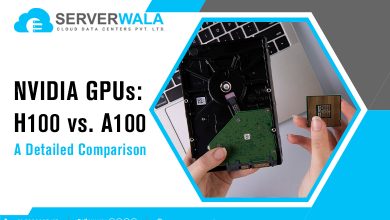Unveiling the Powerhouse: A Comprehensive Introduction to NVIDIA L40S Graphics Processing Unit

Preface
Welcome to the cutting-edge world of graphics processing units (GPUs), where innovation meets performance! With this blog, you will attain the insights through the intricacies of NVIDIA’s latest powerhouse, the L40S GPU. Get ready to unveil the magic behind this technological marvel as we delve into its evolutionary journey, key specifications, performance metrics, standout features, & concluding thoughts.
The Progression from L40 to L40S: An Evolutionary Journey
In October 2022, NVIDIA introduced the L40, setting a benchmark for data center GPUs. However, in the dynamic landscape of technology, progress is inevitable, and NVIDIA has elevated the standard with the forthcoming L40S. Termed as the ultimate universal GPU, the L40S isn’t just an cumulative advancement; it represents a substantial stride in terms of performance, features, and capabilities.
The L40S builds upon the solid foundation established by the L40 but propels it to unprecedented levels. Marked by an augmented Thermal Design Power (TDP), the L40S is engineered to tackle the most challenging assignments, making it ideal for small-scale to medium-scale tasks. It excels in applications like Artificial Intelligence training, (LLMs), and multi-workload platforms.
The shift from L40 to L40S transcends numerical upgrades; it’s about delivering a more resilient, adaptable, and efficient GPU capable of addressing the ever-evolving requirements of contemporary data centers.
Key Specifications of NVIDIA L40S
Boasting 48 gigabytes of GDDR6 memory and an impressive bandwidth of 864 gigabytes per second, the L40S is well-prepared for data-intensive tasks, making it a prime choice for applications in AI and machine learning. The substantial count of CUDA cores, totaling 18,176, underscores the GPU’s prowess in parallel computing, a critical capability for scientific simulations and 3D rendering.
The incorporation of advanced Tensor and RT cores facilitates accelerated ML and real-time ray tracing, respectively, rendering the L40S adaptable and proficient in administering proficient workloads. Despite its powerhouse performance, the L40S has a maximum power consumption of 350 watts, a consideration worth noting in the context of data center energy management. Additional features such as a secure boot with root of trust and NEBS Level 3 readiness contribute an additional level of protection and dependability, establishing the L40S as a fitting choice for company-level applications.
These specifications not only position the L40S as a performance powerhouse but also present a variety of features tailored to diverse needs. It does not matter if it is the substantial 48GB of GDDR6 memory equipped with ECC for data integrity or the abundant CUDA cores facilitating concurrent computing, the L40S is engineered to proficiently administer a wide array of applications.
Here are some Measuring Performance Metrics
The NVIDIA L40S goes beyond its impressive specifications to deliver unparalleled performance precisely where it counts. Let’s delve into a comprehensive exploration of the key performance metrics that make the L40S stand out:
Single-Precision Power (FP32):
The L40S demonstrates exceptional single-precision floating-point calculations, boasting a remarkable 91.6 teraFLOPS. This prowess positions it as an optimal choice for a diverse array of scientific and engineering applications, ensuring top-tier performance.
Tensor Processing Supremacy:
The L40S flexes its computational muscles with a peak Tensor performance of 1,466 TFLOPS (accounting for sparsity). This high capability makes it a formidable contender for AI and machine learning tasks, delivering robust performance in handling complex neural network computations.
Real-Time Ray Tracing (RT Core):
The RT Core performance of 212 Teraflops is strategically tuned for real-time ray tracing, significantly intensifying visual rendering abilities. This feature ensures that the L40S excels in applications requiring sophisticated rendering, offering an immersive and realistic graphical experience.
Power Efficiency Excellence:
Despite its exceptional performance, the L40S maintains a commendable maximum power consumption of 350W. This showcases its efficiency, making it an energy-conscious choice without compromising on delivering high-end computing capabilities.
Sparsity Support for Enhanced Efficiency:
The L40S incorporates sparsity support, allowing Tensor cores to process zero values in matrices with heightened efficiency. This innovation brings up in a substantial performance boost, particularly in AI & ML applications where sparse data sets are prevalent.
In essence, these refined functioning metrics establish the L40S as not merely a versatile performer but a master in various domains. Whether tasked with running intricate AI algorithms, rendering detailed 3D models, or simulating complex scientific phenomena, the L40S’s performance capacities rise to the occasion with unparalleled competence and efficiency.
Features of NVIDIA L40S
The NVIDIA L40S transcends mere technical specifications and performance metrics, emerging as a technological marvel with an array of specialized features meticulously crafted to cater to the multifaceted demands of contemporary data centers. Let’s embark on an in-depth exploration of these standout attributes:
Cutting-Edge Fourth-Generation Tensor Cores
The fourth-generation Tensor Cores signify a monumental stride in NVIDIA’s GPU technology, introducing dedicated support for structural sparsity alongside an optimized TF32 format. This innovation yields prompt operation enhancements for AI and data science model training as well as also unlocks novel possibilities for AI-augmented graphics. A prime example is DLSS technology, harnessing these Tensor Cores to dynamically upscale resolution in real-time, thereby enhancing performance in specific applications without compromising visual quality.
Revolutionary Third-Generation RT Cores
Engineered to redefine visual computing, the third-generation RT Cores boasts heightened throughput and parallel ray-tracing and shading capacities. These cores substantially elevate ray-tracing performance, proving particularly advantageous in industries like product design, architecture, and engineering, where impeccable renders are paramount. The hardware-accelerated motion blur and real-time animations further inject a new level of realism.
Groundbreaking Transformer Engine
The Transformer Engine stands as a groundbreaking feature, providing a dramatic acceleration in AI performance. Collaborating seamlessly with the fourth-generation Ada Lovelace Tensor Cores, it intelligently traverses the layers of transformer architecture neural networks. The engine facilitates automatic recasting between FP8 and FP16 precisions, optimizing memory usage and delivering accelerated AI functioning across both training as well as inference activities.
Enterprise-Grade Efficiency and Security
Designed with enterprise-level efficiency and security at its core, the L40S undergoes rigorous testing to ensure peak performance, durability, and uninterrupted operation in 24/7 data center environments. Meeting the latest data center standards and NEBS Level 3 readiness, it includes protected boot with root-of-trust technology, fortifying its reliability in sensitive, high-stakes settings.
DLSS 3 Advancements
DLSS 3 stands as a pinnacle achievement for the L40S, leveraging deep learning & the contemporary hardware discoveries within the Ada Lovelace architecture. This advanced frame-generation technology substantially amplifies rendering performance, delivering higher frames per second (FPS), and minimizing latency. Particularly advantageous in real-time 3D rendering and gaming applications, DLSS 3 ensures a seamless and responsive performance.
Versatility Across Varied Workloads
A compelling facet of the L40S lies in its unparalleled versatility. It does not matter if it is tackling AI training, LLMs, 3D rendering, or multi-workload platforms, the expert features of the L40S position it as a comprehensive solution for a broad spectrum of computing necessities.
Also Read: What are Edge Data Centers? (Complete Guide)
Final Words
As we conclude our exploration of the NVIDIA L40S GPU, it’s clear that this powerhouse is more than just silicon and circuits – it’s a testament to NVIDIA’s commitment to pushing the boundaries of what’s possible. If you are a gamer, content creator, or an expert in the field of AI, the L40S stands ready to redefine your computing experience. In these final words, we reflect on the significance of the L40S and its potential impact on the ever-evolving landscape of graphics processing. Embrace the future with NVIDIA’s L40S – where innovation meets unparalleled performance.





